How Co-Viewing Streaming Could Boost Valentine’s Day For Brands
by Stephen Graveman7 min read
Abstract
- Valentine’s Day is now a big gift-giving holiday; 53% of Americans celebrated and spend over $23.9 billion in 2022
- At the same time, gift disappointment is up: 36.4% of Americans say they have never liked their Valentine’s Day gifts
- This is bad news for brands and advertisers as they see a rise in expensive returns and a drop in ROI
- CTV could be the key: 66% of couples who co-view have a healthier relationship and watch ads together
- CTV’s household targeting means that co-viewing couples are served ads that appeal to their partners’ interests – thus sparking gift ideas that don’t disappoint
Regarding gift-giving holidays, few are as high stakes as Valentine’s Day. Every year, more money is spent on lavish gifts and experiences. Yet, all this gift-giving doesn’t equal gift-loving—14.7% of Valentine’s Day recipients report being unhappy with the gifts they receive. That can result in more than heartache—it can result in expensive returns, inventory or revenue loss, and a missed opportunity to create lifelong customer relationships.
Thankfully, a changing dynamic in the modern relationship—the importance of co-viewing streaming television—could be the key to preventing broken hearts for customers and brands alike on Valentine’s Day.
Shoppers Love to Love Valentine’s Day
No longer a day for just a simple greeting card, the modern Valentine’s Day is a holiday of big-ticket items and lavish experiences. In 2022, 53% of Americans celebrated Valentine’s Day and spent over $23.9 billion. While shoppers spent more money than ever on gifts for platonic parties, including friends, co-workers, and pets, the vast majority of revenue—$11.7 billion—is spent on significant others (Fig. 1). The average spend per capita reached $175.41 in 2022.
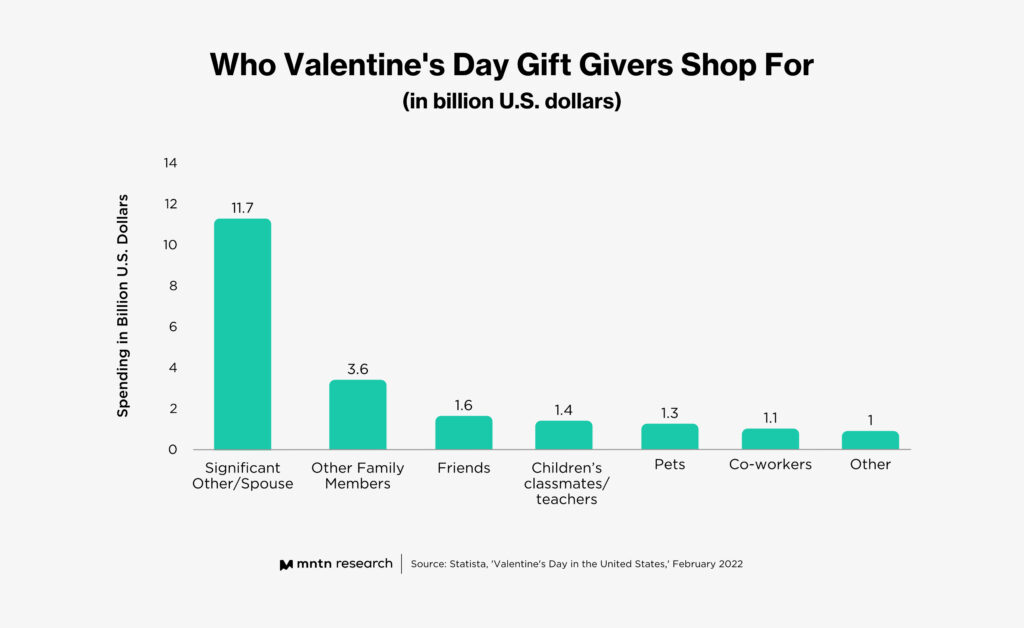
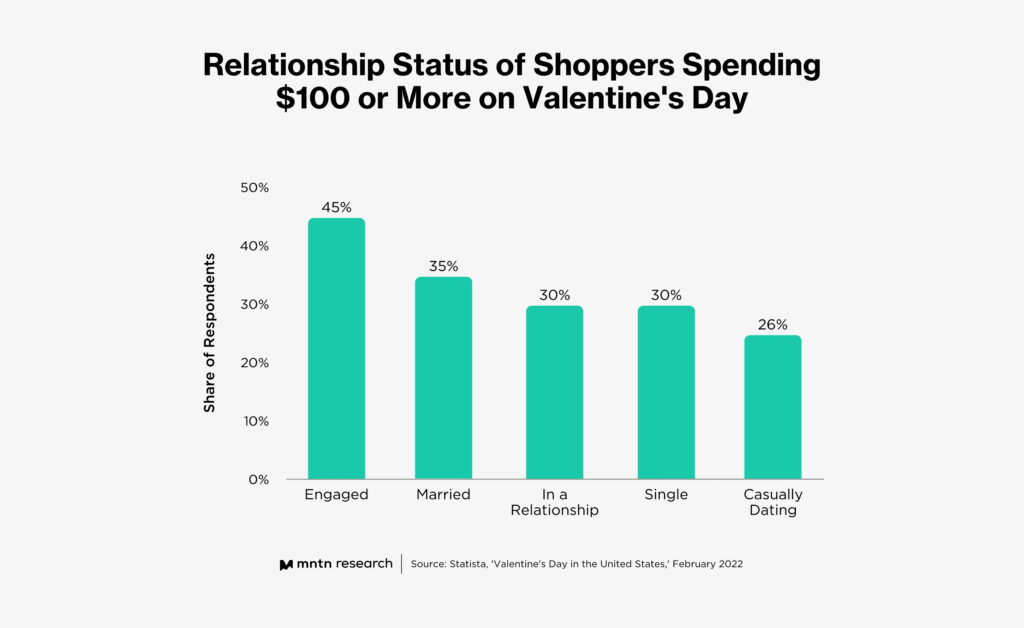
Perhaps unsurprisingly, if slightly cliche, men consistently outspend women on Valentine’s day—$6.2 billion more, almost double that of women. But regardless of gender or relationship status, from engaged to casually dating, consumers plan to spend more than $100 on gifts or experiences for the day (Fig. 2).
Expectations vs. Reality
Despite the increased year-over-year spend on Valentine’s Day, not everyone is happy with the gifts they receive. 34.5% of Americans say they can’t recall the last time they were excited about a Valentine’s Day gift from their partner. Worse, 36.4% say they have never been excited about their gifts.
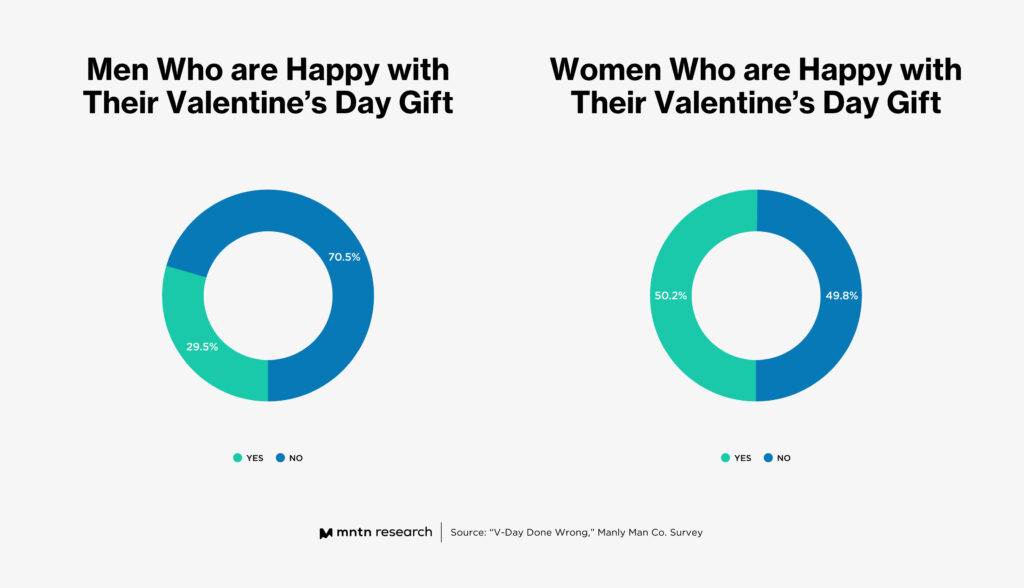
Leading this group of unhappy gift recipients is men (Fig. 3), with 70.5% reporting being secretly unhappy with their Valentine’s Day presents—despite 55.9% saying they have tried to subtly plant suggestions to tell their partner what they want. While unhappy, this group reports not communicating their disappointment for the sake of the relationship, further exacerbating a widening rift between gifts wanted and gifts received.
Women aren’t faring much better, with only 50.2% thinking they get better gifts than their male counterparts (Fig. 3). Meanwhile, most people across both genders think they give the best gifts—50.9% for men and 49.1% for women. So why the discrepancy? It’s likely due to a lack of communication and a reliance on traditional gifts/lack of creativity.
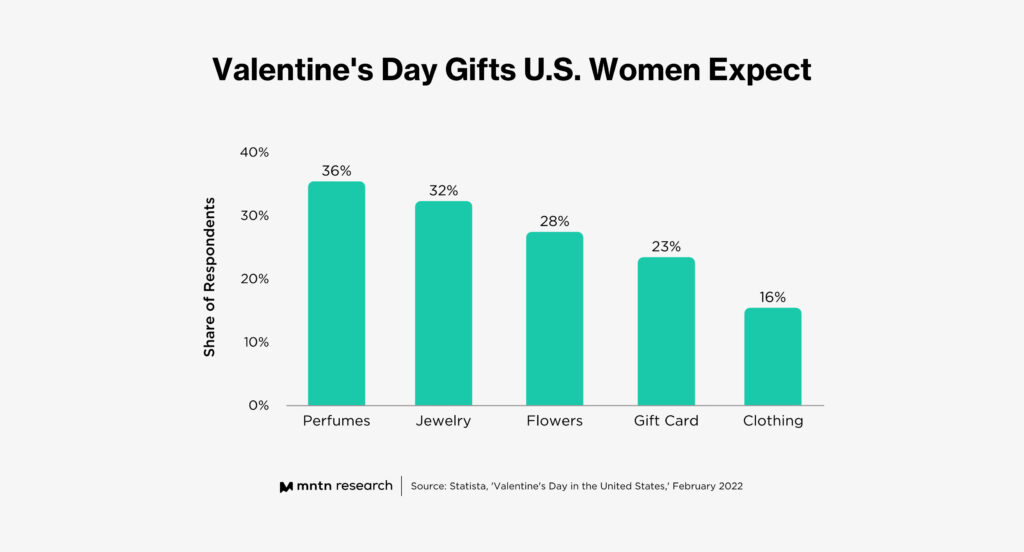
When polled on what they expect to receive, women mostly expect perfumes, jewelry, flowers, or gift cards (Fig 4).
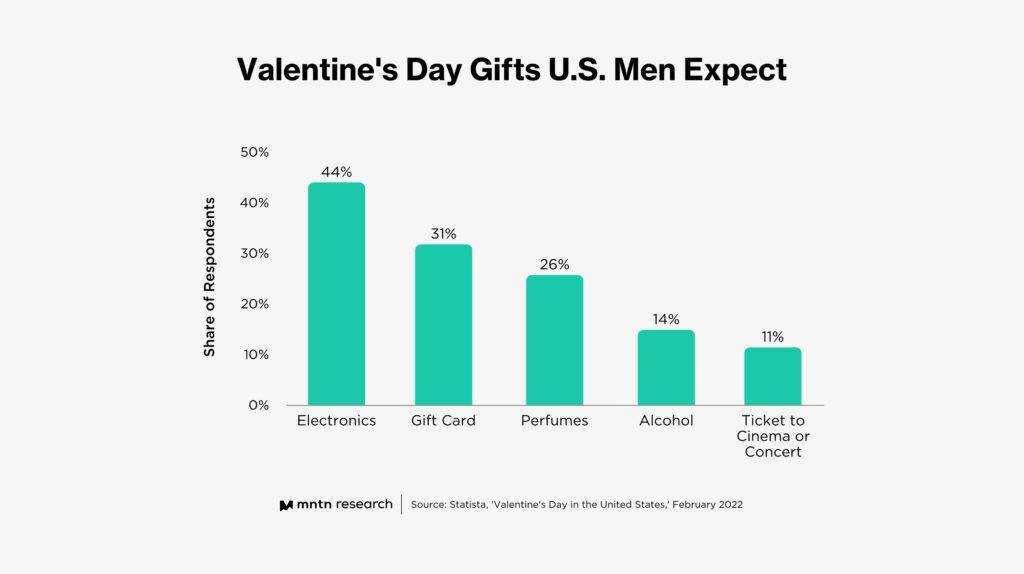
Similarly, most men report expecting electronics, gift cards, or perfumes/colognes (Fig. 5). This demonstrates that both men and women expect certain gifts every year—despite a majority of them wishing they got something else. While these expected evergreen gifts are still popular, they’re not exactly original—and probably less thrilling if they’re received on a yearly basis. Additionally, today’s consumers are craving more experiences and events over physical gifts, especially post-pandemic.
For brands and retailers, this is bad news—returns have increasingly become costly and potentially damaging. Today’s customer expects returns to be easy and hassle-free, including free shipping for returned items, and it’s costly for stores to handle returns. Does the item go back on the shelf? Is it sold at an open-box discounted rate? Or does it move to off-price channels? In the age of online shopping, returns are done without setting foot in a store, preventing opportunities to convert customers to other merchandise.
For advertisers, this also demonstrates that their targeting might be missing the mark. While they might be finding their audience demographic through inventory buys on linear TV or other ad channels, it’s not getting in front of the person making the purchase and final decision. With marketing teams tightening their belts and economic anxiety a concern for brands this Valentine’s Day, it’s crucial for every ad dollar to be reaching its full potential.
No Longer a Third Wheel: The TV
Just as the concept of the Valentine’s Day gift is evolving, so too is television’s place in the modern relationship. No longer seen as a solitary experience with one party watching their favorite shows alone, TV is now a social engagement that brings couples together. While the advent of the DVR and streaming heralded the end of “appointment TV,” what emerged in its wake is on-demand co-viewing (the act of couples watching TV shows together).
30% of couples admit to canceling social engagements to watch their favorite TV shows together while 55% of parents report even putting their children to bed early to watch their favorite show together. And 30% of single millennials say that they have ended relationships or turned down dating someone based on their TV preferences. This co-viewing isn’t just determining plans or dating lives: it’s also strengthening existing relationships.
A study by Propeller Insights and Xfinity on 1,935 adults aged 25-49 found that 66% of couples that co-view TV have a healthier relationship. This is likely creating a cyclical effect—couples watch TV together, bringing them closer, which results in them spending more time together and increasing their co-viewing habits.
Watching TV shows together has become so important that a colloquial—and serious—name has been given to the activity of watching a show behind your partner’s back: “Netflix cheating.”
A few years ago, Netflix released some stats on this phenomenon, saying that 48% of couples report committing to streaming infidelity. Perhaps more surprisingly, 14% say that this behavior is a deal-breaker (to make that number look paltry, 40% of Hong Kong viewers say Netflix cheating is worse than an actual affair).
A Match Made in (Ad) Heaven
These two seemingly disparate trends in relationships overlap in a powerful opportunity for brands to advertise this Valentine’s Day. Because CTV uses household IP data to target audiences, CTV ads are targeted based on personas living under one roof. And with so many of these personas watching shows together, it’s likely that they’re being served ads that favor their partner’s interest—and vice versa.
As a result, viewers in a relationship are getting ads that appeal to themselves as well as their significant other. And since these couples are likely to be watching together, this opens the opportunity to not just inspire gift ideas—it creates opportunities to spark conversations and show interest in gifts to one another.
Connected TV also enables smaller or emerging brands, or ones that feature products and services that don’t fit the “traditional” Valentine’s Day gift concept, to not get lost in the shuffle of global chocolate brands or nationwide florist chains. By targeting audiences likely to convert, and serving them ads alongside the person who’s doing the gift-giving for them, all brands are able to compete on a level playing field.
Conclusion
Valentine’s Day’s importance as a gift-giving holiday will only continue to climb in the coming years, which is why it’s critical for brands to ensure their ads are hitting their target audience, driving home the maximum return on ad spend, minimizing the risk of gift returns, and forming new customer relationships,
By leveraging CTV’s targeting capabilities and the rise of TV co-viewing, these brands can use today’s ad technology and changing relationship dynamics to create a happily-ever-after experience.
Subscribe to the MNTN Research Weekly
Sign up to receive a weekly feed of curated research, sent straight to your inbox.